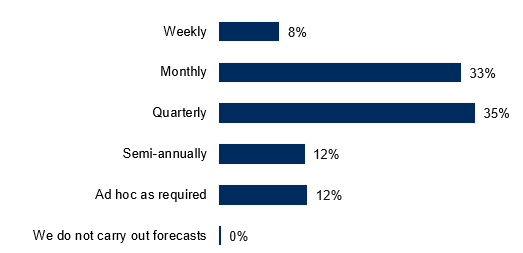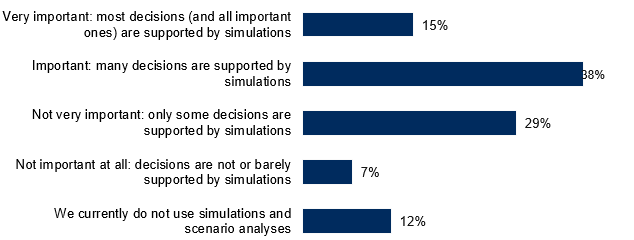
The New Normal? – How corporate planning and corporate management must adapt to the increasing dynamics of the market and competition (2)
In the first part of this three-part blog series, you learned about the effects of increasing dynamics on corporate planning and corporate management and how both topics must adapt to the "New Normal". In part two, you will learn why forecasts are replacing traditional budgeting as the central instrument for corporate management and why simulations are the essential basis for the well-founded analysis and evaluation of action alternatives, opportunities and risks.
Forecasts are replacing classical budgeting as the central instrument for corporate management
Sound decisions in dynamic markets require fast and up-to-date forecasts. Increasing dynamics mean that classic annual planning (budgeting) is losing value for companies because its update cycles are simply too long and it is therefore difficult to derive short-term management impulses on the basis of current data. On the other hand, short-term forecasts and predictions are becoming more important. The frequency of updating forecasts in companies is therefore constantly increasing. Whereas quarterly updates used to be the norm in the past, now it is monthly, if not weekly or sometimes even more frequently. More than 40 percent of companies update their forecasts and projections at least once a month (see Figure 3) in order to take into account changed signals from their environment for management decisions. Without well-founded software support (see also part 3 of this blog series), the effort required to update forecasts would invariably be disproportionate to the benefits, or it would simply take too long to derive insights for short-term management decisions.

Figure 3: How regularly are your planning figures updated during the year? (Source: BARC “Sound Decisions in Dynamic Times – Forecasts and Simulations Support Modern Corporate Management”, n=265)
An important current trend in forecasting is therefore the use of predictive algorithms, statistical methods and machine learning (ML), which are used for predictive planning and forecasting. The aim is to generate meaningful and high-quality planning figures with the least possible effort and a fast throughput time. Predictive algorithms are the ideal way to automate and accelerate forecasts, but they are not a panacea. In order to generate the hoped-for benefits, the technology must be assessed realistically. Since predictive algorithms and machine learning learn from the past, highly dynamic markets with a high degree of unpredictability can present an insurmountable challenge for automated forecasts, since there are no recurring "patterns" that could be learned from historical data. Companies should therefore not trust the technology "blindly", but it is essential to clarify for which use cases and under which environmental conditions good results can be generated with less effort in order to relieve those responsible for planning from routine activities. The basis for an efficient solution is the concentration on the essentials as well as the willingness to accept compromises in favor of speed if necessary. The balancing act between depth and efficiency is a learning process for many companies. However, increasing dynamics and thus the pressure to change are forcing organizations to adapt their corporate planning and corporate management to the new situation faster than ever before.
Simulations are the basis for the well-founded analysis and evaluation of action alternatives, opportunities and risks
In dynamic markets, predictability is generally limited. Accordingly, companies have to evaluate different ways to reach their goals and prepare for possible future developments. The means of choice for this is simulations, the use of which, however, is by no means universal. Simulations allow the analysis of different scenarios based on mathematical business models and variable input values (parameters). The detailed comparison of scenarios helps to evaluate the influence of changes as well as the resilience of companies and thus provides important insights for corporate management. Scenarios – both positive and negative – must be enriched with risk assessments and measures in order to evaluate probabilities and possible alternatives for action. The simulation of scenarios is a decisive factor in competition in order to prepare for future developments in the best possible way and to identify opportunities and risks. Driver-based simulation models are particularly suitable for transparently demonstrating the effects of changes in individual influencing factors or measures in simulations and scenario observations.
The importance of simulations for corporate management has multiplied. Many companies increasingly recognize the necessity and added value of scenario planning and analysis. The main reasons for this are increasing dynamics and the associated uncertainty. More than 50 percent of organizations now use simulations regularly to better estimate the effects of important decisions (see Figure 4). The majority of companies plan to make more extensive use of simulations in the future. This makes simulations and scenario analyses clearly one of the most important areas of investment for improving corporate planning and corporate management in the coming years.

Figure 4: How important are simulations and scenario analyses in your company for corporate management and decision support? (Source: BARC “Sound Decisions in Dynamic Times – Forecasts and Simulations Support Modern Corporate Management”, n=268)
In summary, it can be said that only agile companies that adapt their corporate planning and corporate management to increasing dynamics can achieve top performance in competitive markets in the long term. Short-term forecasts and well-founded simulations are important, beneficial elements of modern corporate management.
In the third and final part of this three-part blog series, you will learn why specialist software support is essential for fast and up-to-date forecasts as well as sophisticated simulations and scenario analyses.





